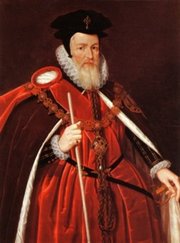Lord High Treasurer
|
|
The post of Lord High Treasurer or Lord Treasurer is an ancient English (after 1707, British) government position. The holder of the post functions as the head of Her Majesty's Treasury, and is third highest Great Officer of State. Since the brief tenure of Charles Talbot, 1st Duke of Shrewsbury in 1714, the office has been held not by a single person, but by a board of several individuals known as Lords Commissioners of the Treasury. By convention, the Prime Minister serves as the "First Lord of the Treasury," and the Chancellor of the Exchequer serves as the "Second Lord of the Treasury." Other members of the Government (usually whips in the House of Commons) are appointed to serve as the junior Lords Commissioners.
Origins
The English Treasury seems to have come into existence around 1126, during the reign of Henry I,as the financial responsibilities were separated from the rest of the job that evolved into Lord Great Chamberlain. The Treasury was originally a section of the Royal Household with custody of the King's money. In 1216, a Treasurer was appointed to take control of the Treasury in Winchester. The Treasurer was also an officer of the Exchequer, and supervised the royal accounts. By Tudor times, the Lord High Treasurer had achieved a place among the Great Officers of State, behind only two others:the Lord High Steward and the Lord Chancellor.
During the sixteenth century, the Lord High Treasurer was often considered the most important official of the government, and became a de facto Prime Minister. Exemplifying the power of the Lord High Treasurer is William Cecil, 1st Baron Burghley, who served in the post from 1572 to 1598. During his tenure, he dominated the administration under Elizabeth I.
The Modern Commissioners
A rarely-varied system has evolved since then. Today, the First Lord of the Treasury is as a rule the Prime Minister, and the Second Lord of the Treasury is the Chancellor of the Exchequer, who has inherited most of the functional financial responsibilities.
The Chief Secretary to the Treasury is also of Cabinet rank and is the senior deputy to the Chancellor of the Exchequer. Other Government ministers holding the title Secretary to the Treasury are the Financial Secretary to the Treasury, who ranks alongside the Ministers of State, and the Economic Secretary to the Treasury, who ranks along the Parliamentary Under Secretaries.
The Parliamentary Secretary to the Treasury is the chief Government Whip in the House of Commons, and after him rank, in order, the Treasurer of the Royal Household, the Comptroller of the Royal Household, and the Vice-Chamberlain of the Royal Household (one of these three is always at Buckingham Palace as a symbolic hostage during the State Opening of Parliament), and only then the "junior Lords of the Treasury" who are the regular Government Whips, even though theoretically they are members of the Treasury Board and the head of the whips' office not even that board's chief secretary. (Assistant Whips round out the Whips' Office and are not Lords Commissioners).
From all of these the Permanent Secretary to the Treasury must be distinguished, as he is not a politician but the department's senior civil servant, considered second in rank among all civil servants to the Secretary to the Cabinet.
See also
- List of Lord High Treasurers for a list of holders of the office of Lord Treasurer, Lord High Treasurer, and Commissioners of the Treasury.

